Last update 5/2/2024
So, ok, you’ve decided to take on the challenge of learning how to play the guitar. First off, congratulations! You’re about to head on a journey that will lead to a great deal of personal gratification—being able to play guitar may be one of the most satisfying things that you’ll do. If you haven’t yet decided on the variety of guitar types that are right for you, great; let’s look at all the popular guitar types available.
Types of Guitar
Table of contents
The guitar is an iconic stringed instrument that has evolved over time. It’s taken on many different forms and styles to cater to diverse musical genres and player preferences. The guitar’s history and versatility have led to several distinct types, each with unique characteristics and sonic signatures. From the traditional acoustic models for folk music to electric guitars that helped define rock and roll.
We look at the array of guitar types and discuss the craftsmanship, engineering, and artistry of each one. Understanding the nuances among these guitar types will help you understand the breadth of possibilities available to players.
Suppose you are a beginner trying to make sense of all the guitar variations so that you can make a buying choice or an experienced player considering trying something new. In that case, The guide will help you understand the differences between the most popular guitar types.
That being said, there’s no doubt that there’s much to learn. First, you’ll ask, ‘What type of guitar do I need to hit the ground running? It may be a bit more involved than you think. There are numerous styles, enough to make you dizzy. Picking the best guitar for you may seem like a hard decision to make.
Types of Guitar list
No need to let yourself get overwhelmed – we’ve got you covered! Let’s take a few minutes and look at all of the different types of guitars available. So, Once you are well informed, you can decide which guitar type is the right one for your needs.
Make an informed decision.
Our guide will give you all the information you need to decide to buy. In addition, you will find even more details in our guitar-buying guides that dive into more points for your chosen guitar type. At any rate, you will see them listed last at the end of this guitar types guide.
Take notes


When your first guitar. Having your notes on hand is particularly useful if you plan to try a bunch of guitars in various stores.
Your Budget
Decide on a budget, and set your minimum and maximum spending. You might be considering an acoustic; in that case, we say buy the best acoustic guitar you can afford. For the most part, the law of diminishing returns does apply here.
Your Playing style
It’s helpful to know the playing style that you are after. Some guitars lend themselves better than others for specific musical styles.


Are you going to play:
- Fingerstyle, Flatpicking, or just strumming.
- Are you seeking a specific tone?
- Do you plan to sing and play the guitar?
Types of Guitar Acoustics


We’ll start where it all began – the time-honored acoustic guitar.
This is where the rubber hits the road. Various guitar types suit different requirements.
Acoustic guitars are extremely popular guitars. Compared to electric guitars, the acoustics are as simple as possible. In essence, there is an acoustic for every playing style imaginable. There’s no need to buy amplifiers, effect pedals, cables, etc. Acoustics are incredibly versatile; they honestly pick up and play. They are a great choice if your budget is tight; no additional need to be purchased.
“When you play the 12-string guitar, you spend half your life tuning the instrument and the other half playing it out of tune. – Pete Seeger”
Acoustic guitar – 6 string


An acoustic guitar is about as simple as you can get from a construction standpoint. The overwhelming majority of models are made entirely of wood. However, a select few use more modern materials.
Overall construction for an acoustic guitar consists of a wood ‘neck’ and a hollow ‘box’ called the ‘body.’ The body has a top, back, and formed sides that can be found in various sizes and shapes—each with its characteristics.
For example, a dreadnought style tends to be bigger, giving more volume projection and deeper sound. In contrast, you can also get much smaller parlor models. Parlor guitars are potentially better to play for those with smaller hands. In addition, they are easier to transport as well.
There aren’t many options other than using steel as far as strings are concerned. Furthermore, other metal materials are used, such as nickel and bronze. Mostly, you’ll hear acoustic guitars called ‘steel-string acoustics.’
Acoustic guitar – 12 string
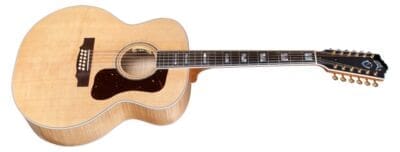

Twelve-string acoustics are perfect for strumming; they have great depth and sparkly sound. They’re not miles apart from six-string acoustics, however. However, they play very much the same; the strings being so close together might take some time.12 Strings are used for the most popular genres of music, pop, rock, and Country especially. In addition,12 strings are tuned a little differently, giving that unique sound.
Popular acoustic manufacturers are Martin, Taylor, and Yamaha. Each has a complete line of various acoustic guitar types with different sizes, features, and options.
Acoustic lap steel guitars (Hawaiian guitar)
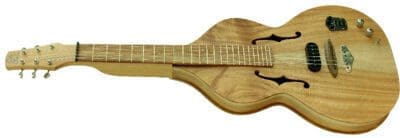

Typically played across the performer’s lap in a horizontal position. The string’s pitch is changed by pressing a polished metal bar onto the plucked strings of the instrument. This instrument does not have frets. However, position markers look very similar to frets. The acoustic lap steel should not be confused with a pedal steel guitar. Unlike the pedal steel guitar, the acoustic laps still do not use a pedal.
Acoustic guitar sizes


There are a wide variety of acoustic guitar body types available from manufacturers. There are plenty of variations to choose from; let’s look at the main types now. Generally speaking, the larger the guitar’s body, the louder the volume.
The 00, double-O is also known as the grand concert body. The Grand Auditorium acoustic guitar is also called the triple-O (000). It is much like the ‘Grand Concert.’ Many of the 000-guitar types come with a convex back to enlarge the physical volume of the soundbox.
The result is a balanced tone similar to the 00 but with more dynamic range and volume and a little more low-end. It’s those features that have made this classic-shaped body extremely popular.
Martin’s 000-xxx series and the Taylor guitars type x14 series are much-appreciated examples of the Grand Auditorium style.
The Jumbo acoustic
They are generally the most prominent acoustic guitars of them all. Jumbos suit players who are strong strummers. They have a big, powerful sound.
The Dreadnought
Dreadnoughts are a prevalent guitar because they have a lot to offer. They suit various strummers, fingerstyle, bluegrass, and flat pickers. Furthermore, they also provide big, strong bass and are loud. Dreadnoughts are also very popular with more prominently framed people and much less for smaller-framed people. Smaller, framed people often complain about the discomfort of draping their arms over the instrument’s body.
Parlor
The parlor is old-style and popular with guitarists seeking a smaller guitar. The Parlor guitar is a narrow-waisted, compact guitar often used as a travel guitar. Its name is derived from the rooms often played in the late 19th century. They are appreciated by players who seek a lightweight and small guitar.
Travel acoustic guitars
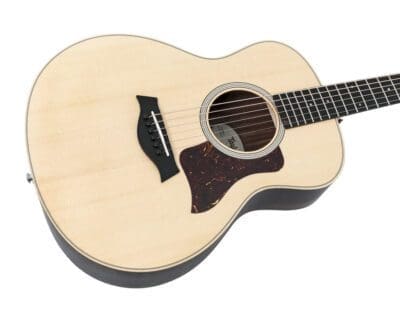

It is a small and light guitar for people who travel a lot. They are not known for their tonality or high volume output. The Taylor GS Mini is a popular guitar for people who travel often; it is smaller without sacrificing its sound.
Mini acoustic guitars
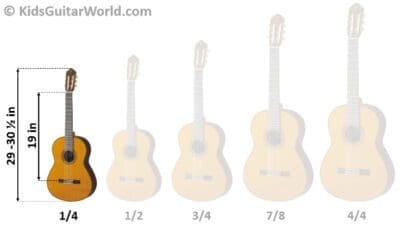

Designed with children in mind, they are 3/4 to half the average size of most guitars—a popular choice for kids learning to play.
Guitar manufacturers have variations of guitar types and sizes.
Acoustic-electric guitars


- With an acoustic electric (A/E) guitar, you’ll have the ability to take the classic steel-string acoustic (not to be confused with a ‘classical guitar‘…more on that later) and add the ability to amplify the sound easily.
- A/E guitars have some pickup and preamp systems installed right off the shelf. This allows you to plug it into a guitar amplifier or a direct box to a PA for live performance. You can also use it directly in an audio interface if recording a guitar is your thing.
- Pickup types differ from units that fit under the bridge saddle and transfer the vibrations to models that use a tiny microphone inside the guitar’s body. Some of the best setups have both; each provides unique tones that can be blended into a very rich, complete, and defined tone.
- A/E guitars are typically extended models of traditional acoustic guitars, so all significant guitar manufacturers offer them as part of their product lineups.
Acoustic guitars | Cutaways


Acoustic-electric guitar allows access to the upper frets on the neck of the guitar by designing a “cutaway” into the guitar body. Some traditionalists frown upon cutaway acoustic guitars; some say it’s abominable. However, if you plan to play up the neck, we won’t hesitate to say get an acoustic cutaway.
Archtop acoustic guitars


An Archtop guitar is usually a full-bodied semiacoustic guitar or hollow-bodied; they have been named Archtops because of their distinctive arched top. The Archtop is very popular amongst Blues, rockabilly, and jazz players. They are loved for their sound, which is punchy with enhanced projection. There are many variations of Archtops, and they typically have the following features.
- The guitar’s top is arched rather than flat as with most guitars.
- An Archtop is usually a semi-acoustic or hollow body.
- It has six steel strings.
- F-holes in the body, for instance, are similar to a violin in style.
- It has a moveable adjustable bridge.
- A rear-mounted tailpiece, a Bigsby vibrato tailpiece, or a stop-tail bridge.
- The neck is joined at the 14th fret.
Flat-top acoustic guitars


A Flattop guitar is a guitar that uses a flat top as opposed to a carved top or an arched top. The majority of your traditional acoustics are constructed with a flat soundboard. The term “flattop” is sometimes stated to clarify that the guitar uses a flattop.
Selmer (Maccaferri)
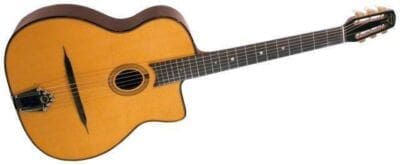

Often associated with Gypsy Jazz, the acoustic Selmer Maccaferri Style guitar has a distinctive D-shape soundhole.
Semi-acoustic guitars


The semi-acoustic (for example, the thin line or hollow-body electric guitar) is different from a standard acoustic guitar in the following ways:
It uses an acoustic pickup. However, it can be played with or without amplification.
Pros of Acoustic Guitars
- No need for amplification: You can play anywhere without needing an amp, making them portable and convenient.
- Natural tone: Produces a warm, rich sound that is pleasing to the ear.
- Develops good technique: Requires more finger strength and dexterity, which improves overall playing.
- Cost-effective: No need for additional equipment like amps and pedals.
- Variety of styles: A wide range of styles suits different musical tastes.
- Versatility: Can be played for various genres, from folk and blues to rock and pop.
- Good for practice: Playing without an amp forces you to focus on your playing and technique.
- Environmentally friendly: No need for electricity.
Cons of Acoustic Guitars
- Difficult for beginners: Heavier strings and wider fretboards require more finger strength and dexterity.
- Limited volume: Can be difficult to play in loud environments or with other instruments.
- Susceptible to damage: More fragile than electric guitars due to the hollow body.
- Limited sound options: Unable to achieve the same range of sounds as electric guitars with pedals and effects.
- Tuning stability: Can be affected by temperature and humidity changes.
- Limited playability in quiet settings: Can be too loud for practicing in some settings.
- Cost can vary: While generally cheaper than electrics, high-quality acoustic guitars can be expensive.
- Difficult to upgrade: Not as easy to modify sound with pickups and effects.
Classical guitar types (Nylon Strings)
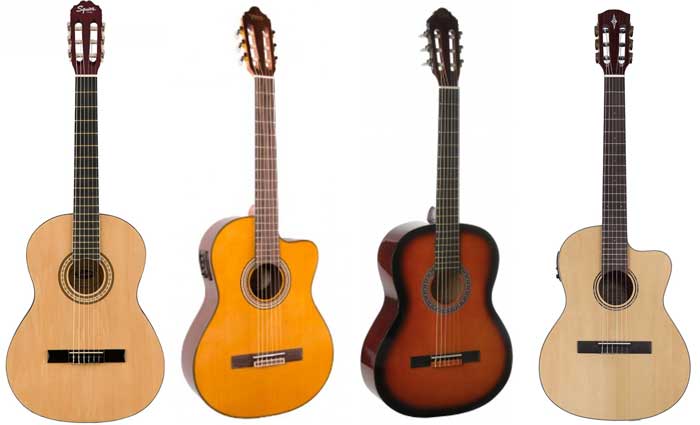

Classical guitars come in a variety of types, each with its own distinctive qualities and tonal characteristics. Here’s a breakdown of some of the main types:
Traditional Classical Guitar
These guitars are the standard when you think of classical music. They feature a wide, flat neck, a round soundhole, and a body shape that emphasizes a balanced tone.
Known for their warm and mellow sound, they are favored by classical musicians for their ability to produce rich, resonant tones ideal for intricate fingerpicking and melodic playing.
Flamenco Guitar
Flamenco guitars are built to emphasize volume, responsiveness, and percussive qualities. They typically have a slightly thinner body compared to classical guitars.
Their sound is characterized by a bright, snappy tone that cuts through, perfect for flamenco music’s rapid, rhythmic strumming and tapping techniques.
Requinto
With a smaller-sized classical guitar, the requinto produces a higher pitch than standard classical guitars.
Often used in Mexican music, it has a bright and lively sound that complements mariachi bands and adds a distinct flavor to ensembles.
Tres Cubano
Originating from Cuba, the tres cubano is a three-course guitar known for its distinct, crisp sound and percussive playing style.
Its three pairs of strings contribute to a unique harmonic richness, making it an essential element in traditional Cuban music like son and bolero.
Romantic Guitar
Smaller in size compared to standard classical guitars, the romantic guitar was popular in music during the Romantic period.
It has a more intimate and delicate sound, perfect for playing lyrical and emotive pieces popular during the 19th century.
So there you have it; each type of classical guitar has its own allure, catering to different musical styles and preferences. Whether it’s the warmth of traditional classical tones, the fiery energy of flamenco, or the unique timbres of smaller variations.
Pros of Classical Guitars
Pros
- Warm and rich sound: Classical guitars produce a warm, rich sound that is ideal for solo playing and fingerstyle arrangements.
- Comfortable and easy to play: The nylon strings are softer on the fingers than steel strings, making them more comfortable to play.
- Good for beginners: The wider neck and string spacing make them easier to learn than other types of guitars.
- Versatile: Classical guitars can be used to play a wide variety of music, from classical to flamenco to jazz.
- Lightweight and portable: Classical guitars are relatively lightweight and portable, making them easy to take with you wherever you go.
- Durable: Classical guitars are well-built and can last for many years with proper care.
- Develops good technique: Playing classical guitar requires good technique, which can also benefit your playing on other types of guitars.
- Improves finger dexterity and strength: Playing classical guitar helps improve finger dexterity and strength, which can also be beneficial for other activities.
- Good for music theory: Classical guitar music is often written in standard notation, which can help you learn music theory.
- Great for fingerstyle playing: Classical guitars are ideally suited for fingerstyle playing, a popular technique for solo guitar pieces.
- A wide repertoire of music: A vast repertoire of music has been written for classical guitar, so you will never run out of new music to learn.
Cons of Classical Guitars:
Cons
- Limited volume: Classical guitars are not as loud as steel-string guitars, which can limit their use in certain situations.
- Nylon strings: Nylon strings can be more susceptible to breaking than steel strings.
- Not as versatile as some other types of guitars: Classical guitars are primarily designed for classical music and may not be the best choice for other genres of music.
- More expensive: Classical guitars can be more expensive than other types of guitars, especially if you are looking for a high-quality instrument.
- Can be difficult to learn: Classical guitar music can be challenging to learn, especially for beginners.
- Fingernails can interfere with playing: If you have long fingernails, they can interfere with your playing.
- Not as good for strumming: Classical guitars are not designed for strumming, so they are not the best choice for playing rhythm guitar.
- Limited effects options: Classical guitars typically don’t have pickups or effects, so you are limited in the sounds you can create.
Electric guitars
These instruments have become synonymous with diverse musical genres, from jazz’s smooth tones to metal’s raucous energy. But with such variety, navigating the world of electric guitars can be daunting, especially for newcomers. Let’s have a look at the different types of electric guitars. We will comment on their unique characteristics and their pros and cons.
Solid Body Guitars
These are the workhorses of the electric guitar world, featuring a solid wooden body that minimizes unwanted feedback and provides a bright, sustain-rich tone.
Types
Stratocaster


With its three single-coil pickups and five-way selector switch, this iconic design offers a versatile range of tones, from sparkling clean to searing distortion. The Stratocaster is a rock, blues, and country music mainstay popularized by legends like Jimi Hendrix and Eric Clapton.
Telecaster
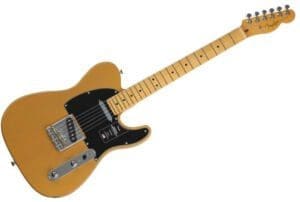

Known for its twangy, punchy sound and simple two-pickup configuration, the Telecaster is a favorite among country and rock players. Its minimalist design and distinct tone have earned it a place in the hands of iconic guitarists like Bruce Springsteen and Keith Richards.
Les Paul Electric Guitar
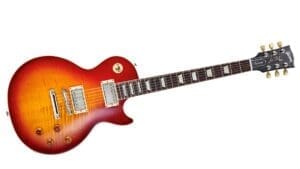

The Gibson Les Paul is a heavy, mahogany-bodied guitar that features two humbucker pickups, delivering a thick, warm tone with incredible sustain. It’s the go-to choice for blues, rock, and heavy metal players, championed by Jimmy Page, Slash, and countless others.
Great for
- Rock
- Blues
- Country
- Metal
- Funk
- Pop
Semi-Hollow Body Electric Guitar
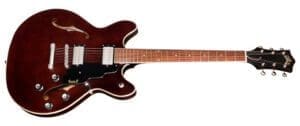

A compromise between solid-body and hollow-body guitars, these instruments feature a hollow chamber with a solid center block, providing a warmer tone with reduced feedback compared to fully hollow models.
Types
ES335 Electric Guitar
With its balanced sound and elegant aesthetics, this iconic Gibson design is a favorite among jazz and blues players. Its versatility has also made it popular with rock and pop musicians.
Great for
Jazz
Blues
Rock
Pop
Country
Hollow Body Electric Guitar


Known for their warm, rounded tone and distinctive acoustic quality, these guitars feature a fully hollow body, offering a unique playing experience. However, their susceptibility to feedback limits their use in loud settings. The Epiphone Casino is a well-known guitar that has a hollow body.
Types
Archtop
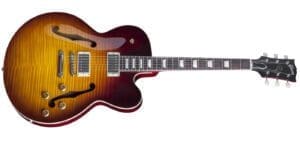

With a distinctive arched top design, these guitars are popular in jazz and swing music due to their rich, mellow sound.
Great for
- Jazz
- Swing
- Blues
Boutique Electric Guitar
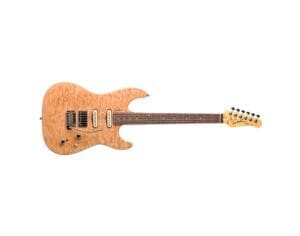

Built by independent luthiers, these instruments are renowned for their exceptional quality, unique designs, and meticulous attention to detail. They offer diverse tones and playing experiences, appealing to discerning musicians seeking something truly special.
Great for
- All Genres
Pros and Cons of Electric Guitars
Pros
- Wide range of tones
- Can be played at loud volumes
- Versatility
- Can be customized with pickups and effects
- Amplification allows for diverse sound shaping.
Cons
- Requires an amplifier and other equipment
- Can be expensive
- It can be more difficult to learn than acoustic guitars
Finding Your Perfect Electric Match
With so many options available, choosing the right electric guitar can be a challenging but rewarding experience. Consider your musical genre, desired tone, playing style, and budget to narrow down your search. Experiment with different models and find the one that speaks to your musical soul. Remember, the perfect electric guitar is the one that inspires you to create and express yourself freely.
In summarizing the article on guitar types, it’s clear that the world of guitars encompasses a wide range of instruments, each with its distinct sound, shape, and application. Classical guitars offer nuanced tones suitable for fingerstyle playing and classical music, while acoustic guitars provide a versatile sound that fits a variety of genres, from folk to rock. Electric guitars allow for a broad spectrum of effects and styles, playing a key role in the development of modern music genres. Bass guitars, in both electric and acoustic forms, lay the rhythmic and harmonic foundation of many musical pieces. Specialty guitars, like the twelve-string, resonator, and extended-range guitars, provide unique sounds for specific musical explorations.
Each guitar type serves a specific musical purpose and appeals to different players based on personal preference and the requirements of their musical genre. Whether one is starting their musical journey or looking to expand their collection, understanding these differences can inform their choice and potentially enhance their musical expression.
The guitar industry continues to innovate, offering improvements in sound quality, playability, and design. This ongoing evolution suggests that new types of guitars and advancements in existing models will emerge, further enriching the musical landscape. Choosing a guitar becomes an informed decision based on understanding each type’s characteristics and how they align with the player’s needs and aspirations. This guide aims to clarify the diverse range of available guitars, highlighting their roles in music creation and performance.
Transparency disclosure: Some of the links in this post are affiliate links, meaning that I may earn a commission if you click on a link and make a purchase. This commission comes at no extra cost to you. We only recommend products and services that I believe are helpful and valuable, and we never let the potential for a commission influence our recommendations.
Shop all guitars types.
Resources
1. Outline of guitars | Wikiwand. Wikiwand. https://www.wikiwand.com/en/Outline_of_guitars. Published 2020. Accessed May 1, 2020.



